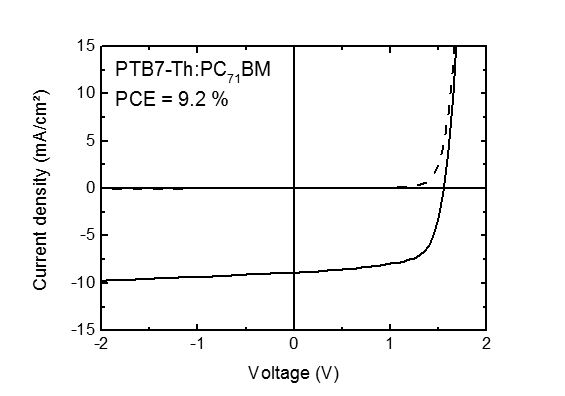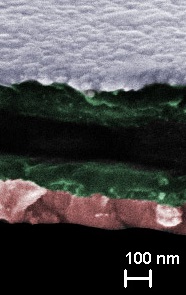Organic Tandem Solar Cells
Organic solar cells are of great interest for many future applications which can’t be covered by conventional photovoltaics technologies. But besides various advantages like mechanical flexibility, tunable colors and use of printable materials, the power conversion efficiency and device lifetime have to be improved for market readiness. One of the most promising approaches to increase the efficiency is to build tandem solar cells comprising two absorber layers in order to cover a broader spectral range and to harvest more light. For organic photovoltaics, architectures comprising two different absorbers and architectures with twice the same absorber material have been shown to have better power conversion efficiency compared to single junction devices.
 |
In organic photovoltaic devices, the tandem architecture can decrease reflection and electrical losses from the electrodes due to the decreased device current. Recently, we realized tandem solar cells comprising PTB7-TH: PC71BM absorber layers with an overall power conversion efficiency of 9.2%. |
 |
For detailed studies of tandem working principles and a better understanding of the subcells’ external quantum efficiencies, we fabricated tandem solar cells comprising a 40nm thin intermediate transparent contact made from a highly conductive polymer (3-terminal device). The introduction of this additional electrode did not influence the optoelectronic properties of our tandem devices but allowed to measure the two subcells separately. All results can be transferred directly to conventional 2-terminal tandem solar cells. |
Further reading:
- D. Bahro et al., Understanding the External Quantum Efficiency of Organic Homo-Tandem Solar Cells Utilizing a Three-Terminal Device Architecture, Adv. Energy Mater., 2015, 5, 1501019, DOI: 10.1002/aenm.201501019.
- K. Glaser et al., Organic Tandem Solar Cells, Book chapter in C. Brabec, V. Dyakonov, U. Scherf (Editors) Organic Photovoltaics, Wiley-VCH Verlag GmbH & Co. KGaA, 2nd Edition 2014, ISBN: 978-3-527-33225-0.
- A. Puetz et al., Solution processable, precursor based zinc oxide buffer layers for 4.5% efficient organic tandem solar cells, Org. Electron., 2012, 13, 2696-2701, DOI: 10.1016/j.orgel.2012.07.043.
- A. Puetz et al., Organic solar cells incorporating buffer layers from indium doped zinc oxide nanoparticles, Sol. Energy Mater. Sol. Cells, 2011, 95, 579, DOI: 10.1016/j.solmat.2010.09.020.
- A. Colsmann et al., Organic tandem solar cells comprising polymer and small-molecule subcells, Appl. Phys. Lett., 2006, 89, 203506, DOI: 10.1063/1.2388938.